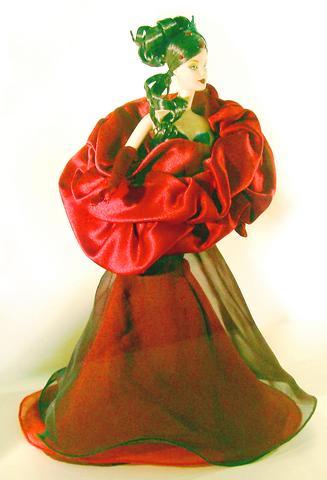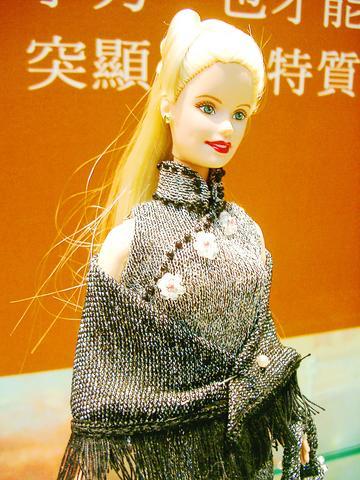I'm a Barbie girl, in a Barbie world. Life is plastic. It's fantastic!"
Twenty years ago, Lin Ah-ching (
From 1967 to 1987, Taishan was home to the flagship factory of Mattel Ltd, producing Barbie dolls for the world. Each day the factory produced 50,000 to 60,000 doll heads. Lin was one of the 8,000 workers who worked in this small semi-industrial township.

PHOTO: YU SEN-LUN, TAIPEI TIMES
Following the opening of Taiwan's first Doll Museum last month, the little-known past of Taishan has come into the spotlight again.
"Look, this part of her body is made by the revolving machine. And for the hair, we had to sew the hair circles then use ovens to make [the hair] curl," Lin said, pointing to a doll in the museum and recounting her 20 years of making Barbies.
Lin said she originally worked in a clothing factory in Taoyuan and in 1967, Mattel set up and she moved to Taishan to become one of the earliest employees in the factory.

The business soon took off and peaked in the 1980s. The factory was divided into many departments that included body-shaping, spray-painting, hair-implants and sewing.
"For example,
Barbie's eyes, eyebrows, cheeks and lips, and also Ken's hair, are all made by spray paint," Lin said.

Teng Cheng-ming (
Mattel in Taiwan was a joint venture between Mattel and Hua-hsia Plastic (
"In the beginning, it was very primitive. There was no machine for us to curl the hair. We had to use chopsticks and wire to roll up the hair and use rice cookers to steam it. But you could not steam too much or it would damage and blur the paint for the doll's eyes," Lin said.
The factory became so busy, the work needed to be contracted out to workers outside of the factory. Thousands of housewives took up the piece-work jobs, doing knots, sewing buttons and laces, or putting on little shoes and earrings for the dolls.
Ku Tsuei-eh (
Ku said she if worked hard, she earned NT$360 a day. At that time, Lin Ah-ching's salary was NT$700 a month. A Barbie doll, however, cost NT$1,200. In today's NT dollars, that works out to more than the price of a Louis Vuitton bag.
Factory community
It was, therefore, common for the employees to take home a Barbie doll. "People would think you were weird if you didn't take one home," Lin said.
Some would hide the doll in their bell-bottomed pants. Others took hands and legs in their underwear to assemble at home.
This made the company hire security. "Whenever security showed up, workers would give signals to each other and some had to throw away the dolls out into the rice fields. Sometimes they threw them into people's houses," Ku said.
Of course, workers caught carrying a doll home were sacked immediately. Generally, according to Teng, also a labor-union member at Mattel, the company treated its employees fairly well.
"The company put in plenty of employee-welfare funds. We ate well and had parties in the factory. It was like a big family. We dated the girls and got married here," said Teng, whose wife was also a Mattel employee.
In 1984, employees were informed that the factory would move its operations to Indonesia and China and the factory closed in 1987. There were no disputes or fights from the labor side, as the union negotiated a severance fee with the management.
Each worker was paid between NT$100,000 and NT$200,000. But the local economy suffered.
Ku Tsuei-eh now serves in the Taishan Township Office and Community Rebuilding Team. He was one of those behind the setting up of the doll museum. The museum now displays 400 differently clad Barbie dolls, as well as antiques and photos of the history of Mattel in Taiwan.
"The doll-making was a major part of Taishan Township. So we want to restore doll-making culture in this town," Ku said.
In the past five years of preparing the doll museum, the team set up workshops for Taishan residents to learn designing and making clothes for Barbie dolls. The workshop also invited old employees, such as Lin and Teng, to talk about their experiences.
Recounting her days at Mattel, Lin Ah-ching feels that living in Barbie's world was accidental but nice.
"It was all about making a living. I was never a big fan of dolls and I never had the luxury of collecting them. But I know how to make a perfect doll," she said.
For your information :
Taishan Doll Museum: 26, Lane 26 Fengchiang Road, Taishan, Taipei County (
Telephone: (02) 8531 1406

Sept. 1 to Sept. 7 In 1899, Kozaburo Hirai became the first documented Japanese to wed a Taiwanese under colonial rule. The soldier was partly motivated by the government’s policy of assimilating the Taiwanese population through intermarriage. While his friends and family disapproved and even mocked him, the marriage endured. By 1930, when his story appeared in Tales of Virtuous Deeds in Taiwan, Hirai had settled in his wife’s rural Changhua hometown, farming the land and integrating into local society. Similarly, Aiko Fujii, who married into the prominent Wufeng Lin Family (霧峰林家) in 1927, quickly learned Hoklo (commonly known as Taiwanese) and

The low voter turnout for the referendum on Aug. 23 shows that many Taiwanese are apathetic about nuclear energy, but there are long-term energy stakes involved that the public needs to grasp Taiwan faces an energy trilemma: soaring AI-driven demand, pressure to cut carbon and reliance on fragile fuel imports. But the nuclear referendum on Aug. 23 showed how little this registered with voters, many of whom neither see the long game nor grasp the stakes. Volunteer referendum worker Vivian Chen (陳薇安) put it bluntly: “I’ve seen many people asking what they’re voting for when they arrive to vote. They cast their vote without even doing any research.” Imagine Taiwanese voters invited to a poker table. The bet looked simple — yes or no — yet most never showed. More than two-thirds of those

In the run-up to the referendum on re-opening Pingtung County’s Ma-anshan Nuclear Power Plant last month, the media inundated us with explainers. A favorite factoid of the international media, endlessly recycled, was that Taiwan has no energy reserves for a blockade, thus necessitating re-opening the nuclear plants. As presented by the Chinese-language CommonWealth Magazine, it runs: “According to the US Department of Commerce International Trade Administration, 97.73 percent of Taiwan’s energy is imported, and estimates are that Taiwan has only 11 days of reserves available in the event of a blockade.” This factoid is not an outright lie — that

Former Chinese Nationalist Party (KMT) chairwoman Hung Hsiu-chu’s (洪秀柱) attendance at the Chinese Communist Party’s (CPP) “Chinese People’s War of Resistance Against Japanese Aggression and the World Anti-Fascist War” parade in Beijing is infuriating, embarrassing and insulting to nearly everyone in Taiwan, and Taiwan’s friends and allies. She is also ripping off bandages and pouring salt into old wounds. In the process she managed to tie both the KMT and the Democratic Progressive Party (DPP) into uncomfortable knots. The KMT continues to honor their heroic fighters, who defended China against the invading Japanese Empire, which inflicted unimaginable horrors on the